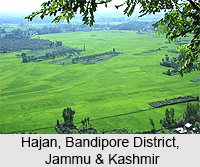 Hajan is a Municipal Committee city, located in the Bandipura (Bandipore) District of the Indian state of Jammu & Kashmir. It comes under the Sonawari sub-district and is divided into 13 wards for which elections are held every 5 years.
Hajan is a Municipal Committee city, located in the Bandipura (Bandipore) District of the Indian state of Jammu & Kashmir. It comes under the Sonawari sub-district and is divided into 13 wards for which elections are held every 5 years.
Geography of Hajan, Bandipore District, Jammu & Kashmir
The notified committee city of Hajan is situated at an altitude of 1,556 metres (5,105 feet) above mean sea level.
Demographics of Hajan, Bandipore District, Jammu & Kashmir
As per the Census India 2011 report, the total population of Hajan stands at 13,239, of which 7,133 inhabitants constitute males and the remaining 6,106 constitute females. The sex distribution ratio of the city thus comes to 1.17 approximately.
The population of children between 0 to 6 years of age is 1618, being 12.22 per cent of the total population of the city. The Female Sex Ratio (population of females per 1000 males) is 856, against the state average of 889. The Child Sex Ratio (population of girl child per 1000 male children) is around 800, lower than the state average of 862.
Literacy in Hajan, Bandipore District, Jammu & Kashmir
The literacy rate of Hajan city is 47.49 per cent, compared to the state average of 67.16 per cent. The male literacy is around 56.32 per cent, while female literacy is about 37.18 per cent.
Administration of Hajan, Bandipore District, Jammu & Kashmir
Hajan Municipal Committee has administration over a total of 1,781 households, to which it supplies the basic amenities like water and sewerage. The committee is also authorised to build roads within its territory limits and impose taxes on properties coming under its jurisdiction.
The city of Hajan predominantly comprises Muslim population, with Urdu being the official spoken language. The economy of the city centres on agriculture and farming, animal husbandry and tourism.
This article is a stub. You can enrich by adding more information to it. Send your Write Up to content@indianetzone.com



















